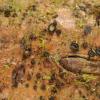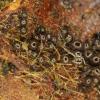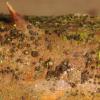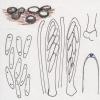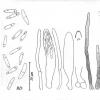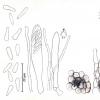
21-02-2014 18:34
HI to all I'd like to know some idea about this p

21-02-2014 08:21
 Maren Kamke
Maren Kamke
Hi everybody,a week ago I found this pyreno on woo

13-02-2014 14:53
Found Attica Greece, dimensions 0,3-0,7 mm, in so

18-02-2014 15:35
Found in soil in forest with Cupressus sempreviren

19-02-2014 22:05
 Yannick Mourgues
Yannick Mourgues
Trouvé ces derniers jours sur Buxus décortiqué

19-02-2014 11:45
Bonjour. Je ne suis pas un habitué des forum, mai
Voici un petit ascomycète récolté le 18/02/2014 sur tige morte de Rubus (fructicosus ou voisin), Morre, marais de Saône, Doubs. Altitude 400 m.
Apothècies sessiles, 0,5-(1) mm de diamètre, grégaires ou par deux ou trois ou même isolées, d'abord globuleuses puis cupuliformes. Hyménium blanc quand bien ouvert sinon, de gris à noirâtre. Marge et surface externe couvertes de poils certains à sommet hyalin.
Asques clavifomes à sommet ogival, 35-45 x 6-8 µm, J+ très foncé, crochets présents, 8 spores bisériées. Paraphyses cylindriques, hyalines, sans goutte mais contenu un peu spumeux.
Spores plus larges à une extrémité qu'à l'autre, hyalines, avec quelques petites gouttes rares, 8-9 (10) x 2-2,5 µm.
Poils bruns, environ 70 x 4, septés, provenant des cellules globuleuses rondes à polygonales de l'excipulum.
Je joins quelques photos réalisées par JM Moingeon.
Je tourne autour de Pirottaea-Pyrenopeziza et j'arrive sans certitude à Pyrenopeziza escharodes ???
Si vous pouvez confirmer ou infirmer ma détermination, ça me rendrait un grand service.
Merci à tous
Gilbert
Bien cher ami.
Je pense aussi qu’il s’agit de P. escharodes (Berk. & Br.) Rehm. Je te remets, pour comparaison, mes planches de dessins des deux espèces croissant sur tiges Rubus. La seconde étant P. rubis (Fr.) Rehm.
Il y a un moyen, facile, pour distinguer les deux espèces. Il suffit de vérifier si la zone marginale périhyméniale interne réagit ou non en présence de réactif iodé. J’ai découvert cette réaction il a plusieurs années, mais ne l’ai jamais publié, mais cependant indiqué dans certaines publications, notamment dans « Contribution à l’étude des discomycètes » version 2013, chapitre Excipulum, p. 84, disponible online, sur le site Ascomycete.org. La réaction est positive seulement chez P. rubi, et seulement après prétraitement au KOH.
Procédure : faire une coupe transverse, la placer dans le KOK quelques instants, retirer le KOH avec un papier absorbant, mettre une goutte de réactif iodé, recouvrir et observer.
Avec mes salutations et amitiés.
René
Un grand merci pour cette confirmation.
Je n'avais pas grand chose sur cette espèce et n'étais sûr de rien.
Merci encore et bon dimanche.
Gilbert

